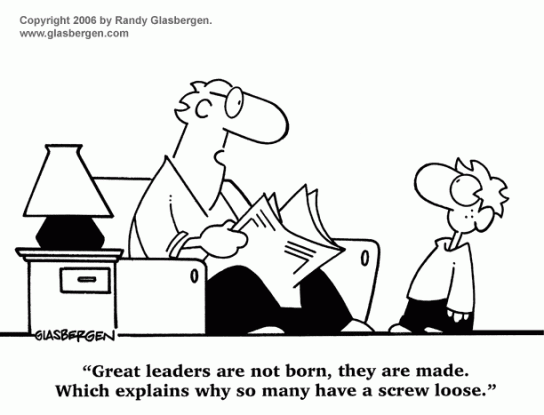Last week, I shared 5 leadership examples and asked you to distinguish which ones are examples of bad leadership vs good leadership. If you haven’t tried it yet, I recommend doing that exercise first before reading any further.
Signs of Bad Leadership

Do you know the top signs of a bad leader? There are many, but here are four signs that are not as obvious.
Sign 1: Cheap words – Just because a leader’s words sounds good, doesn’t mean he or she is a good leader. It’s easy for anyone to say words people want to hear but if a leader doesn’t back it up with action, then it means nothing.
Sign 2: Too much “empowerment” – how can you be too empowered? When your leader isn’t setting direction but tell you, you are “empowered” to set your own. When your leader isn’t saying no holistically to partner on scope but tell you, you are “empowered” to push back and he will communicate what you recommend
Sign 3: “Honest feedback” in a large setting – there is no such things unless you are okay to commit “career suicide.” To give honest feedback to your leader in front of many of your peers is highly unlikely. Rarely does anyone feel comfortable doing that. A large setting intentionally or unintentionally stifles any honesty from anyone as everyone knows embarrassing your leader in front of a group is a career limiting move.
Sign 4: A leader who shares he is powerless – A leader who is empathetic to your needs but then shares that they also cannot help because of x, y, z, is not a good leader. He or she is supposed to help the team solve problems the team cannot. His energy cannot be focused on persuading his team on why he is also a victim.
Example 1: Giving Time Off
It’s Friday before the week of Thanksgiving. The senior product leader in your group sends out a mass email thanking everyone for their hard work and announces that everyone on his product team can take the next week off.
This is an example of bad leadership – see sign 1 – words are cheap. This leader is trying to show he cares for his people but it’s a clear sign of the opposite.

- He didn’t say that deadline for product launches can be moved back a week
- He didn’t say he vetted the decision with all the partner that the team work with and they all agreed to push back timelines for a week
- He did it so last minute, no one on his team has time either to move timelines back themselves.
This is a complete pretense, designed to appear like he cares about his team’s work life balance. In fact, his email has absolutely no impact. Those who needed to work the next week still had to as launches are not pushed back. Those who already planned vacation time was going to do it anyway. Frankly, most people can see through the farce. It probably damaged his leadership reputation.
Example 2: Heart to Heart conversations
The head of product comes to your initiative to speak to the collective team for 30 minutes. This team has 30 product managers in it, 50 tech resources, 20 scrum, program, and support staff. The Head of Product thanks everyone for their amazing achievement and then ask for honest feedback for where she can better help this effort. She says things like “What are some things that should be easy but are hard for you?”

This is another example of bad leadership – see sign 1 and sign 3 above. How can anyone give honest feedback in such a large setting? No matter how constructive a feedback can be, it will always puts the person who offered the feedback at risk in a large setting. Very few people would dare to take that risk.
Even if she is earnest to want honest feedback, she is then lacking the emotional intelligence to realize she chose a setting that guarantees no one speaks honestly. If she really wants to help, she needs to give folks the option to give either anonymous feedback and/or 1 on 1 direct feedback. Further more, she needs to take concrete action to make changes based on the feedback. Without either, it’s just “cheap talk” again.
Example 3: Asking for Feedback
Your leader has asked for anonymous or direct feedback from his direct reports and partners. You can respond anonymously via his admin or directly. For all those who give him direct feedback, he sets up a call to better understand the feedback on his leadership style. Either way, he will share at the end of it with the entire team what he learned and how he will take action to evolve.

This is an example of good leadership. A leader should always be trying to find out he is doing well as a leader and what may be some leadership blind spots. The best way to do that is to ask for feedback from the team and provide a setting that enables maximum honesty – anonymously or via 1-on-1 discussions. This leader is proactively driving toward learning and changing by also sharing back with team what he learned and how he plans to change.
Example 4: Asking for Help from Your Leader
Your leader and his leader set up a small group meeting with six product manager who are working on a difficult initiative with aggressive timelines. The purpose is to have a safe forum to raise concerns to your leaders and get their help. You raised a need for analytical resources as a concern. Your peers echo the same concern. Your leader states to his leader that this has been an ongoing challenge for the last few months. He shares he has tried to solve this with the analytics group and had no luck. The senior leader told everyone – “Okay, I will set up a meeting with the analytics lead.”
This is an example of bad leadership for both your leader and his leader – see sign 1 and 4 above. There are three problems with this scenario
- Why does the team have to be in this meeting? If your leader already knows the issue, he should just address it with his leader if he cannot solve it himself. Dragging two levels of people into this conversation seems like a waste of time.
- For your leader to basically say to his own team and his leader, he is powerless to help seems more like an excuse than anything else. If your leader is a good leader, he should be proposing to his leader how this should be solved by when
- For the senior leader to only say, “I will set up a meeting” leaves this problem open ended. Who owns solving this problem then?
The senior leader didn’t commit to solving it. He only committed to setting up a meeting and didn’t even say by when. Your leader basically provided an excuse why he cannot solve it. While you spend valuable time asking for help, it’s unclear anyone is actually committed to helping you solve it. Given this is an example I witness in real life, I can share that after this has been raised several time for the last 4 months, there is still no resolution and no commitment from anyone to provide additional analytics resource.
Example 5: You are Empowered to Solve
You share with your leader that the timeline that she drafted for senior leadership for the next few launches are too aggressive. The teams are stretched as it is and this new scope is a surprise. She says it’s just a draft and she empowers you as the Agile product lead to push back and come back with what’s a reasonable timeline. She says “We have proven to others that Agile works. I empower you to define the timeline based on your analysis of what can be reasonably done and by when.”

It’s so tempting to think this is an example of good leadership. Unfortunately you would be wrong. This is an example of bad leadership – see sign 1 and 2 above. This leader is in fact not leading or protecting the team at all. It is the leader’s job to set direction and push back on undue pressure on behalf of the whole team. It is the leader’s job to strategize, prioritize and make sure the team has maximize focus on the work. She is creating 2 major problems with this example.
- Why is she sharing a draft timeline without getting your buy in first? She is contributing to the aggressive timeline mindset. Saying it’s a draft doesn’t excuse the fact she jumped the gun and created this expectation with leadership and partners
- If she is “empowering” you to push back when you are already stretched, she is in fact asking you to work more hours to analyze and stand up against aggressive timelines that she inadvertently set.
What Should You Do?

I shared these examples because it’s not always obvious what is bad leadership. By being more skilled at recognizing bad leaders, you can make better choices for your career. You also know what to avoid in you own leadership style.
You cannot change bad leaders but you can change jobs and companies. Vote with your feet and make sure you develop good leadership habits in the future.
Your comments: Do you agree with my assessment of these five examples? Can you share any other signs of bad leadership? I look forward to your comments
Your comments: Do you have an inner voice that tells you that you are not enough? Do you where it comes from and how to ignore it? I look forward to hearing from you.
Like this article? Please share it with your friends and colleagues on Facebook, Linkedin, Twitter, etc…
New to this Site? Start here – How to Succeed like an Executive
I am always in your corner.
Lei
Lei